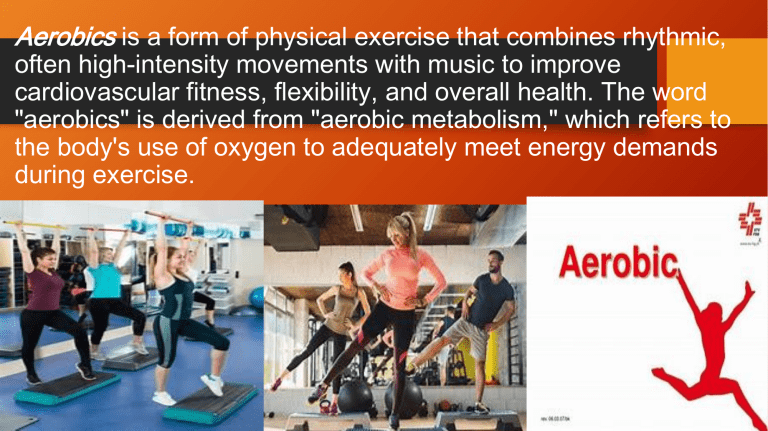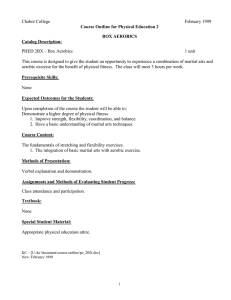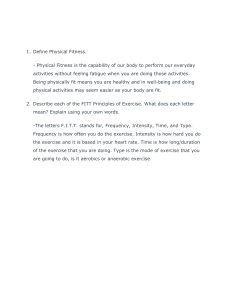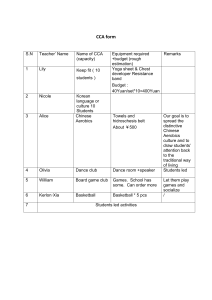
Aerobics is a form of physical exercise that combines rhythmic, often high-intensity movements with music to improve cardiovascular fitness, flexibility, and overall health. The word "aerobics" is derived from "aerobic metabolism," which refers to the body's use of oxygen to adequately meet energy demands during exercise. Origins of Aerobics (1960s and 1970s): Aerobics as a fitness concept began to take shape in the 1960s and 1970s. This period marked a growing awareness of the importance of physical fitness and a shift in the way people approached exercise. Kenneth H. Cooper: Dr. Kenneth H. Cooper, an American physician and Air Force officer, played a significant role in popularizing the concept of aerobics. In 1968, he published the book "Aerobics," where he introduced the term and discussed the health benefits of aerobic exercise. Cooper's work laid the foundation for the modern understanding of aerobics. Jackie Sorenson and Dance Exercise: Aerobics as we know it today can be traced back to the work of fitness pioneers like Jackie Sorenson, who introduced "dance exercise" classes in the 1960s. These classes combined dance movements with music to create an enjoyable and effective form of cardiovascular exercise. Key Figures in Popularizing Aerobics 1970s - 1980s: The Aerobics Craze:: • Jane Fonda: Jane Fonda is one of the most influential figures in the popularization of aerobics. In the early 1980s, she released a series of workout videos, starting with "Jane Fonda's Workout" in 1982. These videos featured aerobic exercises and became a cultural phenomenon, helping people incorporate aerobics into their daily routines. • Richard Simmons: Richard Simmons is another prominent figure known for his energetic and engaging aerobics workouts. His "Sweatin' to the Oldies" videos and television appearances made aerobics accessible and fun for a wide audience. 1990s - Present: Evolution and Diversification: 1. Integration of Other Exercise Forms: Over the years, aerobics evolved to include a broader range of movements and influences. This led to the incorporation of martial arts, step aerobics, and da 2. Group Fitness Classes: Many gyms and fitness centers began offering group fitness classes that incorporated various styles of aerobics. These classes often include a combination of cardio, strength training, and flexibility exercises.nce styles, resulting in a diverse range of aerobic exercise forms. 1990s - Present: Evolution and Diversification: 3. Online and Home Workouts: The advent of the internet and digital media has allowed aerobics to reach a wider audience. People can now access aerobics routines and videos online, making it easier to exercise at home. 4. Aerobic Dance Styles: Dance-based aerobics styles like Zumba, hip-hop aerobics, and dance cardio have gained popularity, offering engaging and fun ways to improve cardiovascular fitness. 5. Aerobics and Technology: The integration of technology into fitness has allowed for more precise tracking of workouts, personalized routines, and interactive aerobic experiences 1990s - Present: Evolution and Diversification: 6. Aerobics for Health and Wellness: While the aesthetic appeal of aerobics remains, there is now a stronger emphasis on its role in promoting overall health and wellness, including stress reduction and mental health benefits. 7. Incorporation of High-Intensity Interval Training (HIIT): Aerobics has also evolved to incorporate elements of HIIT, which combines short bursts of high-intensity exercise with periods of rest or lower-intensity activity. The history of aerobics demonstrates its journey from simple dance exercises to a diverse range of fitness practices that continue to adapt to the changing needs and preferences of individuals seeking to improve their cardiovascular fitness and overall health. It remains a popular and effective form of exercise with a rich history of innovation and development. Key characteristics of aerobics include: Rhythmic Movements: Aerobic exercises involve continuous and repetitive movements, often following a specific pattern or routine. These movements are typically performed for an extended period, usually at least 15-20 minutes. Increased Heart Rate and Breathing: Aerobics elevate your heart rate and breathing rate, which is essential for improving cardiovascular fitness. This sustained increase in heart rate and oxygen consumption is what distinguishes aerobic exercise from other forms of physical activity. Use of Music: Music is a common component of aerobics, as it helps participants maintain a consistent pace and adds an element of fun to the workout. Key characteristics of aerobics include: Full-Body Involvement: Aerobic activities engage multiple muscle groups and promote overall body conditioning. This can include exercises for the legs, arms, and core. Variety of Activities: Aerobics can take various forms, including but not limited to jogging, dancing, swimming, cycling, aerobics classes, and even activities like brisk walking. The primary goal of aerobics is to improve cardiovascular health by strengthening the heart and lungs, enhancing endurance, and burning calories. Some of the benefits of regular aerobics include: -Improved cardiovascular health by increasing heart and lung capacity. -Weight management through the burning of calories. -Enhanced endurance and stamina. -Improved mood and reduced stress due to the release of endorphins. -Better lung function and oxygen delivery to the body's tissues. -Increased flexibility and coordination. -Aerobics can be performed at different intensities, making it suitable for people of various fitness levels. It's a versatile and effective form of exercise that can be customized to meet individual goals, whether it's weight loss, improved fitness, or stress reduction.


